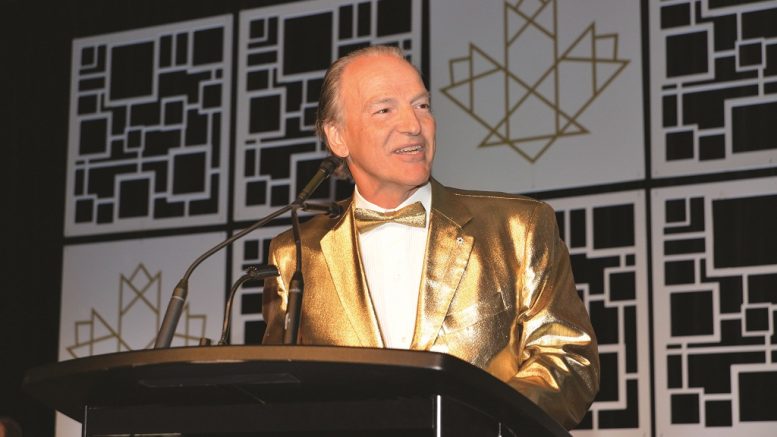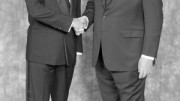Canada’s mining and mineral exploration community gathered at the Metro Toronto Convention Centre in January for the Canadian Mining Hall of Fame (CMHF)’s 30th annual induction ceremony.
With Franco-Nevada chairman Pierre Lassonde serving as master of ceremonies for the 17th year, over 1,225 people were in attendance to celebrate the careers and industry contributions of this year’s four inductees, in order of appearance: Edward G. Thompson, Robert Gannicott, A. Terrance MacGibbon and Ross Beaty.
On the occasion of the 30th anniversary, William Roscoe, chair of the CMHF, paid tribute to the late Maurice Brown, the late publisher and editor of The Northern Miner and CMHF inductee, who “conceived of the Canadian Mining Hall of Fame in 1988. He recognized we needed to honour the legendary characters who laid the foundation our business, to inspire the future generations of mining professionals, and to build an enduring source of information about the people who have made significant contributions to mining.”
The CMHF also used the milestone anniversary to unveil a new crystal-inspired logo and a new award trophy, as well as a refreshed look to its print communications.
Edward G. Thompson
The first inductee was Edward Thompson, a fixture of the Toronto mining scene who helped grow Teck Resources and Lacana Mining (now part of Barrick Gold), and served as a director for more than 50 junior companies.
In more recent years he helped develop an iron ore mine in Quebec and advanced exploration in northern Ontario’s Ring of Fire region.
He has been a leader in expanding the Prospectors & Developers Association of Canada (PDAC) from a provincial to a global force, and was a founding member of the Canadian Mining Hall of Fame.
“He’s just one of those guys that keeps people together — I think the whole industry is like his family,” Teck chairman Norman B. Keevil said in a pre-recorded video shown during the evening. “He’s not a promoter. He’s a true engineer’s engineer. He’s a doer.”

CMHF inductee Edward Thompson addressed attendees from the podium. Credit: Keith Houghton Photography.
Thompson was born in Utterson, Ont., to a family of subsistence farmers and graduated from the University of Toronto with an Engineering Geology degree in 1959, and a Master’s degree in Economic Geology in 1960.
He joined the Keevil Mining Group, where he spent a decade exploring and acquiring projects that later became part of Teck, such as Highmont in B.C.’s Highland Valley, the Tribag copper mine in Ontario and the Niobec mine in Quebec.
His subsequent years with Lacana saw a dozen mines placed in production, including six mines in Mexico, and the Pinson, Dee, Preble, Marigold, Relief Canyon and Santa Fe mines in Nevada — including the introduction of heap-leaching techniques.
He was a director of Granduc Mines, which participated in high-grade gold discoveries at Brucejack Lake in B.C. during the mid-1980s, recently put into production by Pretium Resources.
Thompson was also a director of Freewest Resources in 1981, and later helped it develop the Harker-Holloway gold mine in Ontario. In 2009, Freewest made a chromite discovery in the Ring of Fire, and Freewest was acquired by Cliffs Natural Resources for $239 million in 2010.
Thompson also helped Consolidated Thompson-Lundmark Gold Mines finance and develop an iron ore mine in Quebec. The Bloom Lake mine began production in 2009 and was acquired by Cliffs Canada for $4.9 billion in 2011.
He has also been a volunteer in many organizations, including the PDAC, CMHF, Mining Matters, the Princess Margaret Hospital in Toronto and the Canadian Red Cross.
“I’m not too busy these days,” Thompson confided in the video. “Saley and I are just enjoying life and the grandchildren, and doing a fair amount of travelling. I think I’ve earned it.”
In his acceptance speech, Thompson said he wanted to “stress the importance of friends and family. In my 60 years in business and various associated organizations, I made hundreds of lifelong friends, which I value very highly.
“My family has been the delight of my life, and especially now my seven grandkids … My wife Marie, who passed away nine years ago, was really the rock that kept our family together as I travelled the world. My second wife Saley is a wonderful partner in the second phase of my journey. I’ve been very fortunate to know the love of these two wonderful ladies over my lifetime.”
Robert Gannicott
The second inductee was Robert Gannicott, a pioneer of Arctic mineral exploration who played a key role in the discovery and development of the Diavik diamond mine in the Northwest Territories, among other accomplishments, and helped put Canada on the map as the world’s third-largest producer of rough diamonds by value.
“The thing that impressed me most about Bob was his dedication and determination to have a significant presence in the amazing story of the discovery of world-class diamond deposits in the Northwest Territories, and Bob succeeded in doing that, big time,” Graham Farquharson, founder of Strathcona Mineral Services, told the audience. “He even had an incredible diamond-sorting facility, established here in Canada for the first time ever, which I will never forget touring with Bob.”

Inez Gannicott accepted the award from CMHF director Graham Farquharson, on behalf of the late Robert Gannicott. Credit: Keith Houghton Photography.
Gannicott became interested in geology while exploring caves as a teenager near his home in Sandford, a village in North Somerset, England. He left home in his late teens, taking a boat to Montreal in 1967, and from there catching a train to Winnipeg.
“He was out of money,” longtime friend and colleague Lee Barker, president and CEO of Sparton Resources, recalled in a video presentation. “He basically managed to get himself to Edmonton by loaning his watch to the ticket agent in the Winnipeg train station. He actually did go back and get his watch back.”
From Edmonton, Gannicott travelled to Yellowknife, and got his first job as a geological technician at the Giant gold mine, before returning to school and graduating with a geology degree from the University of Ottawa in 1975.
After graduation, he worked for 12 years as an exploration geologist for Cominco (mostly in the High Arctic at places like the Black Angel lead-zinc mine in Greenland), after which, in 1986, he founded his own company, Platinova, where he focused on exploration in northern Greenland.
In the early 1990s, Platinova discovered the Skaergaard copper-gold and Citronen Fjord base metal deposits, and has been credited with making a key contribution to building the foundations for a modern mineral industry in Greenland. Citronen Fjord has been described as one of the largest undeveloped zinc-lead deposits in the world.
“We didn’t sleep very much,” Barker says of his days with Gannicott on the northern tip of Greenland, noting that they would get by on four hours’ sleep most nights, from three or four in the morning until breakfast at seven. “He wasn’t worried about hardship or living in harsh conditions, or getting his hands dirty,” Barker said. “He was very, very resourceful.”
“Working for him was just delightful because he was so much energy, he was a visionary, and his mind just never stopped,” Lyle Hepburn, a counsel at Markes Lawyers, said on the video, adding that Gannicott was “benevolent” and “tenacious.”
“He was always looking for the solutions and that was one of the reasons why he was so successful, because he never really gave up about thinking about these sorts of things, and what to do next,” Hepburn said.
In 1992, Gannicott started exploring for diamonds in the Northwest Territories, staking claims near Diamet Minerals’ Lac de Gras kimberlite discovery. With some colleagues — including Barker — Gannicott set up West Viking Exploration, a private company, which later merged with Aber Resources. Aber went on to make the Diavik discovery. When they broke the core from the A154 pipe, they found a two-and-a-half-carat diamond.
“When the bulk sample was taken on the A154 pipe there was about a 22,000-plus carat parcel of diamonds that had to be properly sorted and evaluated,” Barker recalled. “Bob pored over these diamonds ad nauseam. I think he had names for them all.”
The discovery attracted Rio Tinto as an operating partner, but Aber kept a 40% stake. The company went on to buy luxury diamond retailer Harry Winston. Harry Winston was later acquired by Swatch, and with the funds, Gannicott bought the Ekati diamond mine, at which point the company’s name was changed to Dominion Diamond Corporation.
“He was a visionary, he was entrepreneurial, he was imaginative,” Jim Pounds, executive vice-president of Dominion Diamond Corp., said during the video presentation. “He was very, very focused once he got an idea in his head.”
Dominion Diamond was acquired by The Washington Companies in July 2017 for US$1.2 billion.
Always passionate about the Far North and its people, Gannicott set up the Robert Gannicott Foundation dedicated to helping indigenous people, and left a considerable sum of money in his will to be used for youth in the Northwest Territories.
In 2013 he was a corecipient of AME BC’s Hugo Dummett Award for excellence in diamond exploration. For his role in building and sustaining Canada’s diamond industry he was awarded the CIM Vale Medal in 2005 and the Members Award in 2007.
Gannicott died of leukemia in 2016.
A. Terrance MacGibbon
Inductee Terry MacGibbon epitomizes the idea that there is plenty more living to do after retirement.
After serving with nickel giant Inco for 30 years as an exploration geologist and executive, MacGibbon transitioned to company builder and mine developer, playing a lead role in creating four substantial mining companies: FNX Mining, Torex Gold Resources, TMAC Resources and INV Metals.
“Retiring the first time, I think I had six hours off,” MacGibbon recalled in a video retrospective. “I retired at midnight on the last day of October and started at eight in the morning on the first day of November.”
As major companies shed non-core assets, MacGibbon was there to pick up high-quality properties beginning with past-producing mines in Ontario’s Sudbury basin, which were placed into FNX. The junior then made discoveries that were developed into seven mines.
“One of the most important things about Terry is that he has a great vision and he sees value,” Jason Neal, global cohead of the metals and mining group at BMO Capital Markets, said in the video. “He certainly sees things early and he’s able to get people organized around opportunities.”

Inductee Terrance MacGibbon speaks at the CMHF induction dinner in Toronto. Credit: Keith Houghton Photography.
Born in New Waterford, N.S., MacGibbon studied dentistry at first, but earned a B.Sc. (Geology) from St. Francis Xavier University in 1968. He joined Inco’s exploration department and climbed the corporate ladder, culminating in him directing Inco’s global exploration efforts.
MacGibbon left Inco in 1997 and drove FNX’s rapid ascent as a substantial player in the Sudbury basin.
For that, he received the 2004 Viola R. MacMillan Developer of the Year Award from PDAC and Ernst & Young’s Entrepreneur of the Year Award in 2005.
In 2010 FNX merged with Quadra Mining to form Quadra FNX Mining, and in 2012, Quadra FNX was bought by a Polish copper mining giant KGHM for $3.5 billion.
MacGibbon used the same strategy to acquire projects for Torex, TMAC and INV: the Morelos gold project in Mexico from Teck Resources; the Hope Bay gold project in Nunavut from Newmont Mining; and the Loma Larga gold property in Ecuador from Iamgold.
As the CMHF writes in its biography of MacGibbon: “These projects all faced challenges, such as escalating costs, lack of community support, and political and taxation issues. MacGibbon applied his ‘three Ps of success’ — perseverance, patience and passion — and built teams of like-minded professionals to help overcome these challenges.”
Torex Gold and TMAC have both become substantial gold producers, and INV has advanced Loma Larga to a point where it could produce within a few years.
In accepting his award, MacGibbon called it a “great honour” and said it was “very humbling to be included with such great inductees.”
He thanked his wife and family and said: “everyone in this room knows the sacrifices our families make to allow us to pursue our careers and to be successful. I missed children’s graduations because of a very important business event. But today, I can’t remember what that event was. So really, how important was it?”
Looking back at the two phases of his career, MacGibbon said that one lesson he’d learned was that “you can never improve on what mother nature has done. However, you can improve on what man has done. This is why we have had success in acquiring non-core assets from large mining companies and then applying out-of-the box strategies, non-layered decision-making and entrepreneurial thinking, and why we were able to turn these non-core and sometimes abandoned assets into great mines and companies.
“A great asset is certainly necessary for success,” he continued. “But by a long shot, people are the most important requirement for success. I have been blessed to have worked with the best, most-talented and ethical people in the mining business.”
Ross Beaty
The final inductee of the evening was Ross Beaty, a geologist and mining entrepreneur who has created an estimated $6 billion of shareholder value through 13 companies since 1994.
His flagship company Pan American Silver is the second-largest primary silver producer in the world, with a market value of over $3 billion, seven mines in Latin America, three in Mexico, two in Peru, and one each in Bolivia and Argentina.
“Ross has been consistently one of the most successful mining entrepreneurs in the industry,” David Scott, CIBC World Markets’ vice-chairman and managing director of mining global investment banking, said during a video presentation. “As a young person I think [he] understood the cyclical nature of the mining business. Ross was able to be decisive and make countercyclical investments.”

Ross Beaty accepts his award from CMHF director Patricia Dillon. Credit: Keith Houghton Photography.
Born in Vancouver in 1951, Beaty had his first rock collection when he was eight years old and studied geology at the University of British Columbia (UBC), graduating in 1974.
“I worked every summer in the bush with different mining companies exploring for minerals and I loved every minute of it,” Beaty said during a video presentation about his career. “I was paid to hike and paid to camp and paid to fly around in helicopters, I just thought, you know, ‘pinch me.’ I mean, I would have done it for free.”
Beaty received a degree in Mineral Exploration from the University of London’s Royal School of Mines in 1975 and a law degree from UBC in 1979.
He started his first company, Beaty Geological, because he wanted to work for himself and didn’t want to be an employee of anyone else. The contract geology company grew to a team of 30 geologists, and was eventually bought by the first junior mining company Beaty created, called Equinox Resources. Equinox developed three mines before it was sold to Hecla Mining in 1994.
His next venture, Pan American Silver, was “by far the most sizeable and frankly most satisfying” of his mining ventures, Beaty said in the video. Among his many other success stories was Lumina Copper, which was eventually divided into six companies that were sold over the years in transactions that created nearly $2 billion of shareholder value.
In addition to the mining companies he created, Beaty launched a geothermal power company in 2008, which expanded to include other forms of renewable energy, including wind, solar and hydro. The company, now called Alterra Power, operates nine geothermal, wind, solar and hydroelectricity plants in Canada, Iceland and the United States.
A passionate environmentalist, Beaty has donated a great deal of money to environmental causes. The Sitka Foundation, which he set up, distributes $3.5 million each year to support more than 72 environmental organizations. He has been a major donor to UBC, which has led to the creation of the Beaty Biodiversity Museum, the UBC Earth Sciences Building and the Pacific Museum of the Earth. Last year he and his wife Trisha gave $5 million to Queen’s University for research into freshwater resources and another $4 million to the Canadian Museum of Nature in Ottawa.
“He’s just an extraordinary, modest and generous fellow,” Don Lindsay, president and CEO of Teck Resources, said during the video. “I’ve seen him make generous donations and his name’s never published, nobody knows.”
In 2017 Beaty was appointed to The Order of Canada. His other awards include PDAC’s Viola MacMillan Award in 2010, the CIM Vale Medal in 2014, and The Northern Miner’s 2011 Mining Person of the Year.
In his acceptance speech, Beaty thanked everyone who had helped him “look good” and who had contributed so much to making Canada “the world’s greatest mining investment capital.”
“You cannot succeed in this business without being lucky, and I’ve been most lucky by having the chance to work with so many people who have helped me look good,” he said.
“I never found any mines, I never built any mines, I just had great colleagues who did, including all the consultants and support teams who helped us.”
Beaty concluded by thanking all the spouses, partners and families of the many people who had helped him build his companies, and all the other companies in the industry. “It’s those partners and their families who often have to sacrifice so much to support the guys like me who get all of the awards,” he said. “It’s time all of us promoters give a shout-out to all of them for their silent support from behind the lines … my son John is here tonight representing my wife Trisha and my other four kids, who spent so many days and weeks without their husband and father, while I roamed around the world chasing my dreams.
“I’ve had an absolutely wonderful ride, and you are all part of my proud induction into the Canadian Mining Hall of Fame.”
— With files from the Canadian Mining Hall of Fame.
The Northern Miner is a founding sponsor of the Canadian Mining Hall of Fame, along with the Canadian Institute of Mining, Metallurgy and Petroleum, the Mining Association of Canada and the Prospectors & Developers Association of Canada.
For more information on the Hall of Fame and how to make a nomination, please visit www.mininghalloffame.ca.





Be the first to comment on "Four Canadian mining giants honoured at CMHF soirée"